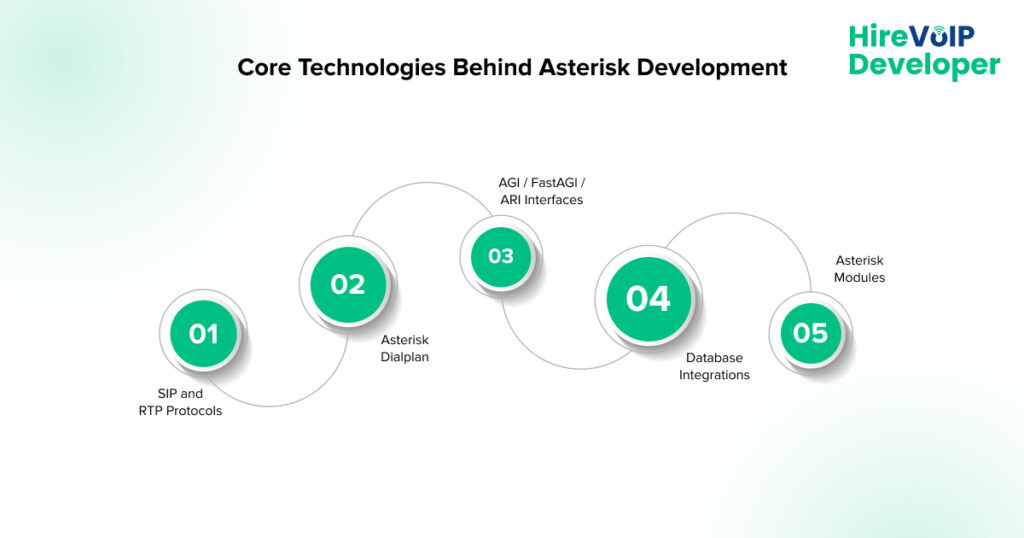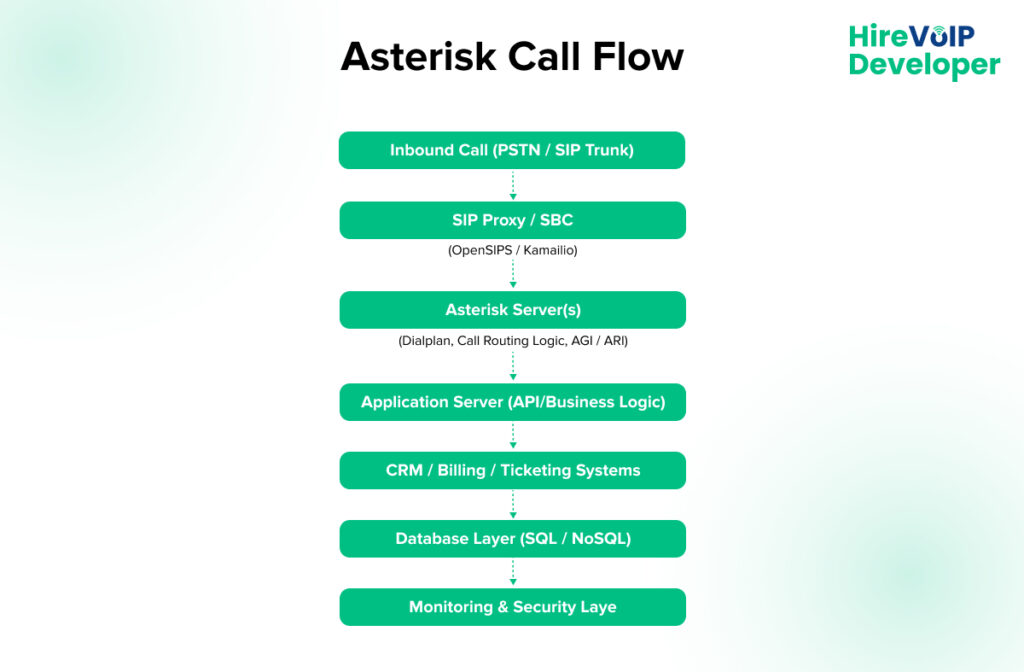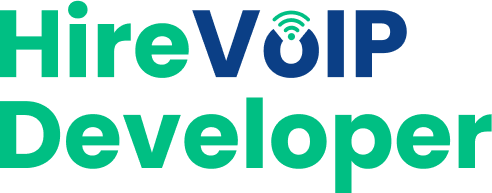📝 Blog Summary
If you’re looking to build or enhance VoIP systems, Asterisk is still one of the most flexible and powerful platforms available. This guide explains what Asterisk development really involves and reveals the insights you need to utilize Asterisk’s full potential for your infrastructure!
Is your telephony system stuck in a legacy trap?
Or are you looking to roll out advanced call routing, conferencing, or IVR features without paying for restrictive commercial solutions?
Asterisk might be the answer, but only if it’s developed and deployed correctly.
Let’s break down what Asterisk development actually looks like today, how custom VoIP solutions are built using Asterisk, and what it takes to hire the right Asterisk development company that can deliver scalable, production-ready systems.
What Is Asterisk Development and How Does It Work?
Asterisk is an open-source communications platform that enables you to build powerful telephony solutions using software and commodity hardware. At its core, Asterisk is a PBX (Private Branch Exchange) engine, but with the right development expertise, it becomes a framework for building almost any voice application you can think of.
It functions as both a toolkit and a runtime environment for creating everything from simple office phone systems to complex contact center platforms that handle millions of calls annually.
Asterisk development involves customizing and extending Asterisk’s built-in modules to match your business logic. This includes:
- Creating custom dial plans using Asterisk’s scripting language
- Integrating with CRMs, external APIs, and billing systems
- Modifying the Asterisk source code or building custom modules for advanced features
- Deploying and maintaining scalable SIP-based communication setups
Unlike prebuilt VoIP platforms, Asterisk gives you full control. But that also means successful implementation requires deep experience with SIP, telephony protocols, and the Asterisk core itself.
Core Technologies Behind Asterisk Development
When developing on Asterisk, several technical components come into play.

SIP and RTP Protocols
Asterisk primarily uses SIP for signaling and RTP for media. Deep understanding of both is required for NAT traversal, codec negotiation, and media handling.
Asterisk Dialplan
Written in extensions.conf, the dialplan controls the flow of calls. Complex call routing logic, IVR menus, and failover handling are defined here.
AGI / FastAGI / ARI Interfaces
These interfaces allow external applications (written in Python, PHP, Node.js, etc.) to control call flows, interact with APIs, and drive intelligent decision-making.
Database Integrations
Asterisk often interacts with MySQL, PostgreSQL, or Redis to store call logs, session states, or fetch customer data in real-time.
Asterisk Modules
Developers can build or modify modules (.so files) to extend Asterisk’s native capabilities, especially for performance-critical or protocol-specific tasks.
Understanding how all these layers fit together is critical to successful Asterisk development services.
🚀 Scale smarter with Asterisk Development today!
Essential Asterisk Development Services You May Need
The scope of Asterisk development services extends far beyond basic phone system setup. Modern businesses require a communications infrastructure that adapts to complex workflows and provides the data visibility needed for optimization and compliance.
Custom Asterisk Development for Unique Requirements
Every business has specific communication workflows that generic phone systems can’t accommodate. Custom Asterisk development creates solutions tailored exactly to your processes. This includes building custom applications that integrate with your existing software, creating specialized dialplan logic for complex call routing scenarios, and developing custom interfaces for managing your phone system.
Asterisk Developer Consulting and Architecture Planning
Successful Asterisk solution development starts with proper architecture. Experienced Asterisk developers analyze your current infrastructure, assess your specific requirements, and design systems that scale with your growth. This planning phase prevents costly redesigns and ensures optimal performance from day one.
VoIP Application Development and Integration
Asterisk development services extend far beyond basic phone functionality. Developers create custom applications for call recording and analysis, real-time dashboards for monitoring call center performance, CRM integration that automatically pulls customer data during calls, and mobile applications that extend your office phone system to remote workers.
Legacy System Migration to Asterisk
Many businesses run outdated PBX hardware that’s expensive to maintain and impossible to expand. Asterisk development companies specialize in migrating these legacy systems to modern Asterisk-based solutions while preserving existing phone numbers, call routing rules, and user configurations. The migration process typically improves reliability while reducing ongoing maintenance costs.
What Can You Build with Asterisk?
Whether you’re a telecom startup or an enterprise modernizing your voice stack, custom Asterisk development allows you to build:
Hosted or On-Premise PBX Systems
Build cloud-native or locally hosted PBX Systems with call routing, voicemail, and multi-tenant support.
Advanced IVR Systems
Route IVR calls based on user inputs, CRM data, or time-based logic.
Voicemail and Call Recording Services
Store, transcribe, and forward voicemails or recordings based on configurable triggers.
Call Queues and Ring Groups
Design call distribution strategies for support, sales, and helpdesk teams.
Voice Broadcasting and Auto-Dialers
Deliver automated outbound calls for marketing or notifications at scale.
Asterisk API Integrations
Connect with payment gateways, ERPs, custom dashboards, or analytics engines through API integrations.
The beauty of Asterisk is that you’re not limited to what’s in the box. If you can imagine it, the right Asterisk developers can build it.
How to Build a Custom Asterisk-Based VoIP Solution? Step-by-Step
Building a tailored voice system using Asterisk involves a lot more than one may think. Here’s what a structured development process typically looks like:
1. Requirement Analysis
Define what business goals the system must achieve, for example, IVR, multi-tenant PBX, call center automation, or something else entirely.
2. Architecture Planning
Design a scalable architecture.
Whether you’re going cloud-native with Docker/Kubernetes or staying on bare metal, decide on SIP trunk providers, NAT handling, and media relay strategies.
3. Core Asterisk Setup and Module Configuration
Install Asterisk, compile necessary codecs, configure SIP endpoints, and load relevant modules (e.g., res_pjsip, chan_dahdi, etc.).
4. Custom Development
- Build dial plans
- Develop AGI or ARI-based integrations
- Set up IVRs or queues
- Integrate with CRMs, ticketing systems, or billing platforms
5. Testing and Deployment
Test call flows, failover scenarios, and media quality. And automate with CI/CD where possible.
6. Monitoring and Maintenance
Use tools like Asterisk logs, RTPengine, and Prometheus exporters for system health and real-time monitoring.
Architecture of an Asterisk VoIP System
Let’s look at what a scalable Asterisk setup typically includes.
Here are the roles that each of these components plays in an Asterisk VoIP system call flow:

Inbound Call (PSTN / SIP Trunk)
The call originates from a public phone network or SIP trunking provider. It enters your system over SIP and begins the journey through your VoIP infrastructure.
SIP Proxy / SBC (OpenSIPS or Kamailio)
Handles SIP routing, NAT traversal, and security at the network edge. Also performs load balancing and protocol normalization before the call reaches Asterisk.
Asterisk Server(s)
Executes dial plans, manages call flow, bridges channels, plays IVRs, and interfaces with APIs. This is the core telephony brain of your infrastructure.
Application Server (API/Business Logic Layer)
External logic (Node.js, Python, etc.) communicates with Asterisk via ARI, AGI, or AMI. It dynamically controls calls based on CRM lookups, business rules, or blacklists.
CRM / Billing / Ticketing Systems
Systems like Zoho, Salesforce, or custom CRMs connect via APIs to log calls, generate tickets, or assign leads. They enrich the call flow with real-time context.
Database Layer
Stores Call Detail Records (CDRs), user configurations, routing metadata, and session logs. Powers dashboards, analytics, and reporting systems.
Monitoring & Security Layer
Monitors SIP traffic, CPU/memory, and call stats using tools like Grafana or Prometheus. Fail2ban, firewalls, and intrusion detection systems secure your VoIP edge.
Also note, scaling can be done horizontally by clustering Asterisk servers behind a SIP load balancer or vertically by optimizing single-node performance.
🔒 Secure. Scalable. Asterisk-powered VoIP System.
When to Hire Asterisk Developers vs Build In-House Teams
The technical complexity of effective Asterisk development often surprises businesses that assume phone systems are straightforward. Modern Asterisk implementations require understanding VoIP protocols at the packet level, experience with real-time systems programming where timing issues can cause audio quality problems, and expertise in security implementation for systems that handle both voice communications and sensitive business data integration.
Cost analysis often reveals that if you hire Asterisk developers, it can help with faster time-to-value and lower total project costs.
Internal teams spend considerable time learning through trial and error, often requiring significant rework as they discover best practices and architectural patterns that experienced developers apply from the beginning.
So, hiring an expert team makes sense when:
- You’re launching a new VoIP product or CPaaS platform
- You’re migrating from a legacy PBX to a SIP-based solution
- You need carrier-grade reliability and call routing intelligence
- You’re integrating voice with other enterprise systems (CRM, support, billing)
- You want to build custom dashboards, reporting, or admin portals
💡 Our Experts Suggest
The biggest red flag when evaluating Asterisk developers is focus on features rather than architecture. Anyone can install Asterisk and configure basic call routing, but enterprise-grade implementations require expertise in distributed systems, database optimization for real-time queries, and network architecture for reliable media transport. Ask candidates about their approach to handling 1000+ concurrent calls, not just their experience with Asterisk modules.
Asterisk gives you the foundation. What you build on top of it (scalable PBX, dynamic call flows, real-time analytics) comes down to the quality of your architecture and the team behind it.
Whether you’re untangling legacy dial plans, integrating real-time APIs, or building multi-tenant VoIP platforms from scratch, expert Asterisk development is what you need. It’s what separates brittle systems from business-critical infrastructure.
Need a team that can architect, develop, and deliver production-grade Asterisk solutions?
We’ve helped telecom providers, enterprises, and SaaS platforms do exactly that. Let’s Talk!


